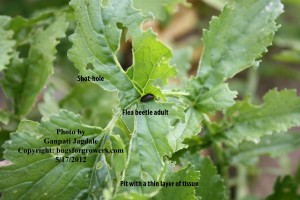Control flea beetles with beneficial Steinernema carpocapsae and Heterorhabditis indica nematodes
Two beneficial entomopathogenic nematodes including Steinernema carpocapsae and Heterorhabditis indica have a potential to use as biological control agents for management of the striped flea beetles, Phyllotreta striolata.
Flea beetles are one of the most damaging pests of cruciferous crops including cabbage (Fig. 1), collard green (Fig. 2) and radish (Fig. 3).


These beetles are small in size about 1.5 – 2.5 mm long with shiny black wings having yellow color wavy lines running the lengths of each forewings for striped flea beetles but other species have black wings with white lines (Fig. 3). Flea beetles overwinter as adults in the previous crop debris in the or around the field. These overwintering adults become active when temperature rises early in the spring. These emerged adults then start feeding on the leaves of young plants. While feeding flea beetle adults mate and their females generally lay eggs in the soil close to host plants. Eggs hatch within week into small larvae that start feeding on the plant roots. While feeding on the roots for two to three weeks, these larvae develop through four developmental stages. Then the mature larvae pupate in the soil. After 7-8 days in pupation, the new generation adults emerge and continue to damage host plants.
The adult stage of flea beetle is more damaging than the larval stage. Adult flea beetles (Fig. 3) feed by scrapping leaf tissue and making circular or irregular pits with some intact thin layer of tissue. As plant grows, the left over thin layer of tissues in each pit dries up and falls and all the pits turn into small shot-holes or irregular holes on the leaves (Fig. 3). This type of damage by flea beetles can eventually kill the young plants.

It has been reported that the beneficial entomopathogenic nematodes including Steinernema carpocapsae and Heterorhabditis indica were effective in infecting and killing soil-dwelling larval (Yan et al., 2013) and possibly pupal stages of the striped flea beetle, Phyllotreta striolata and helping to reduce the emergence of future generation adult flea beetles from pupae.
Both beneficial nematodes can be applied using traditional knapsack sprayers for large area or water cans for a small area. For the effective control of flea beetle larvae, both Steinernema carpocapsae and Heterorhabditis indica nematodes can be applied at the rate of 23000 infective juveniles per square foot area or 1 billion nematodes per care.
Research papers
Yan, X., Han, R.C., Moens, M., Chen, S.L. and De Clercq, P. 2013. Field evaluation of entomopathogenic nematodes for biological control of striped flea beetle, Phyllotreta striolata (Coleoptera: Chrysomelidae) Biocontrol 58: 247-256.
